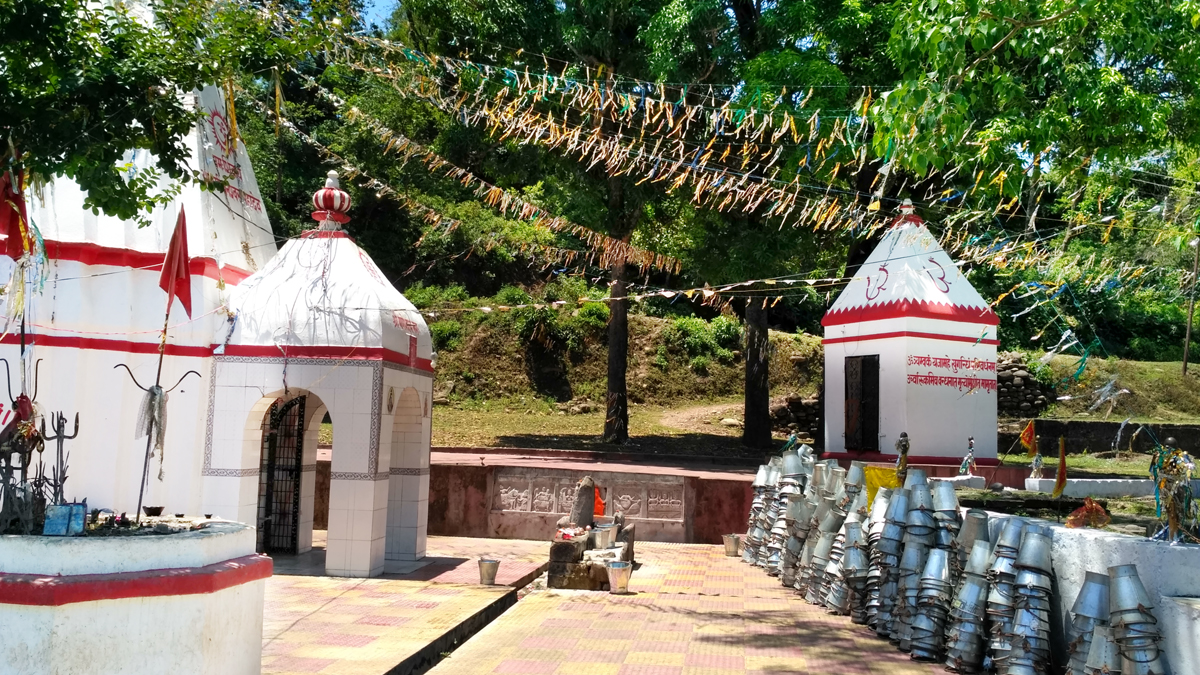Ayodhya Nath Kerni
Jib is a tiny village located 50 kms from Jammu on turning left from Garhi (Jammu -Srinagar national highway) secluded from the humdrum of urban rattling noise and pollution. It is 12 kms from Udhampur. Frequent regular public transport runs from Udhampur to Jib via Garhi and also onwards to other attractive heritage and archaeological sites.
It is beyond one’s imagination while motoring on national highway that there are hill pockets of sheer scenic splendour hidden in parts of Jammu hills endowed with beauty. One such site is surely Jib which tourists and Shiva devotees may prefer to visit. Jib being a hill hamlet has expanded in recent years. The road onwards to Thathi has since been black-topped but a small portion from Garhi to Jib needs repairs and black topping. The repair work seems to be on slow pace. As one reaches Jib bus stand, narrow uneven path through the mane of unpretentious houses leads to an ancient Shiva temple. Walking about half a km on the path one views the sacred shrine a little higher up a stream rushing amid rising verdant hill ranges. The stream is named as Neeli because of its deep blue water. The visitors using their own transport may use the link road leading to an interior village. The most convenient way to reach Shiva Shrine. Out side the temple complex there is lush green trees providing cool breeze and natural attraction is felt as long one stays in the complex.
The Shivalik foot hills in particular is dotted with innumerable heritage sites like forts, temples and baulis etc. While walking over path there are baulis in a small higher up counting to 108, of which only half of them are in working condition and rest are dried up. Most of the baulis in Jammu hills are of similar pattern e.g. natural springs where from water falls through lion mouthed gorgole into a small tank below. On three sides of the bank a masonary work of chiseled stone slabs carved with figures of deities are available in the anecdotal evidence of vedic scriptures. Descending the path crossing the rickety wooden bridge over the stream now washed away, shoals of fish are seen. On reaching the temple premises the visitors see few surprising features of the holy site. The little cave temple inside which one reaches traversing few steps on a slopping ramp inside the outer structure. This is not visible from outside the main temple. The cave shrine appears to have been built in a hollow in the hill side in which one views shiva symbols lingum, trident, snake etc naturally formed and worshipped by devotees. Devotees also make offerings there. The main shrine outside is beautifully constructed with five off sets. It could not be ascertained from the locals that how old the cave shrine is.
According to Hem Raj ordained pujari of the temple, it is believed that temple has been existing over for more than 2700 years. Jib was inhabitated by 12 Jat families who were keeping cattle as their main occupation. The herdsman brought cattle for grazing in the morning and returned them to respective families during evening. There was a complaint in one family that a cow was not giving milk in the evening. The herdsman watched the it and found that during afternoon cow stood over a lingum type stone and milked over it. The herdsman was angry and broke the top of lingum. Due to anger of Lord Shiva these twelve families had to migrate to village Krimchi to atone for the sin of cracking the Shiva Lingum. Later on the villagers gathered and build a temple of small size which was improved from time to time later. The temple was extensively repaired by Ram Saran pujari 75 years back father of present pujari. As recollected by present pujari cement was Rs one and half per bag at that time. The date and year of repair is not known to him. There also exists, the 700 yrs old, live samadi of a mahant. In view of heavy rush of devotees on Shivratri an exit door has been provided by present pujari Hem Raj Saran. While providing exit door it was found that thickness of temple wall was about four feet. The house of pujari is also located adjacent to temple complex. The chequered tiles have been provided to beautify and cover whole of the complex.
On the peripheral wall one can see black stone slabs carved with trinity of Shiva. If a devotee gets his wish fulfilled, he offeres a metallic bucket used by him to pour water over lingum inside the cave temple then the buckets. Thus there are many buckets for pouring water by the devotee. The locals have the conviction that when they are in need of water for their crops they arrange bhandara and it rains. They do cite many examples of the past when Lord Shiva blessed them with rains whenever they felt acute shortage of water.
There are large number of devotees visiting Mata Vaishno Devi Shrine in Trikuta hills. Their stay can be made longer if such hill pockets are provided with infrastructural facilities including connectivity. The visitors prefer to visit lesser known tourist resorts because well known tourists sites are overcrowded and even much costly. So tourist can conveniently make short trips to such fascinating tourist spots like Jib. On the occasion of Shivratri heavy rush is noticed. Local vendors lay out various stalls of eatables or the other articles for the devotees who come for pay respect for Lord Shiva. Bhandara is also arranged on the Shivratri. The need of the hour is to provide stay facilities and highlight such spots so that devotes visiting Mata Vaishno Devi Shrine are attracted to make short trips to such spots.
Trending Now
E-Paper


